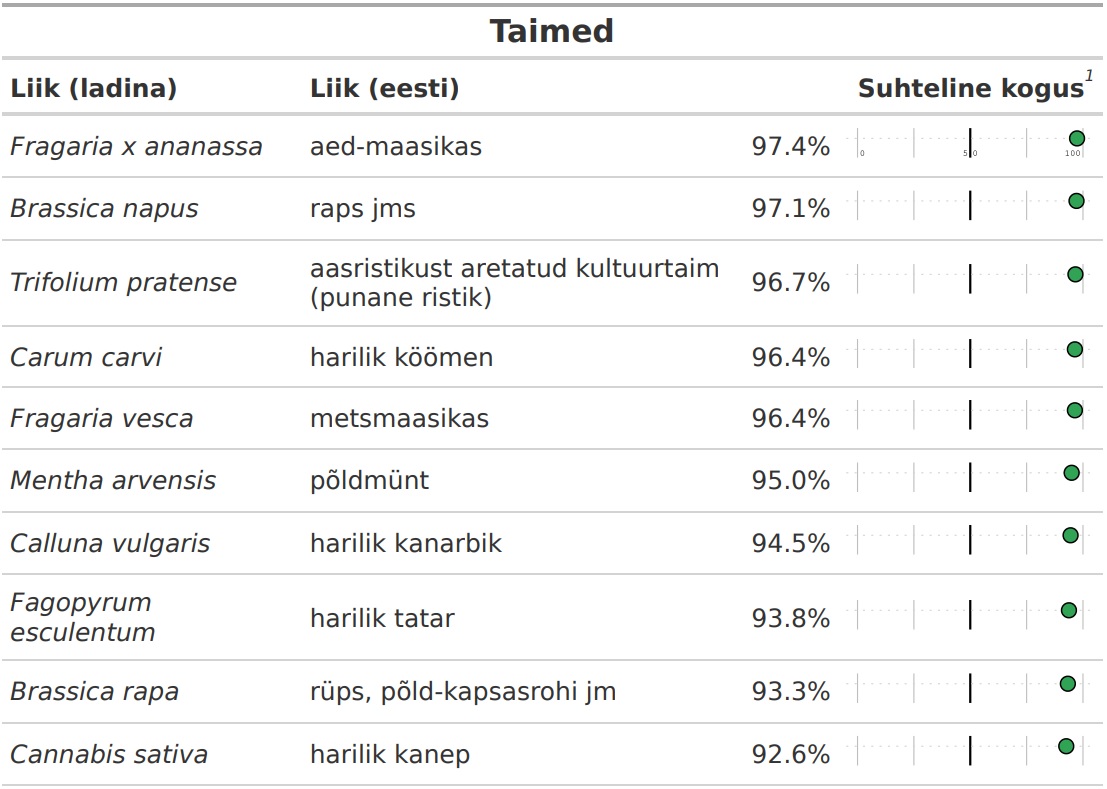Results
Honey DNA analysis results
Plants included in the honey are presented as an interactive diagram
- The DNA analysis result reflects the plants identified in the honey sample and their amounts through the number of DNA sequences.
- The diagram represents the proportions of identified plants. The larger the sector, the more DNA sequences of the species are in the honey.
- The report chart is in HTML format and opens in web browsers. Interactivity allows you to look inside the diagram.


Comparison with DNA profiles of other honeys – plants
Comparison with plant profiles of other honey is carried out with 150 common honey plant species. The value found for each species characterizes the relative amount of that species compared to other honeys. For example, if the value is zero, the DNA of the particular plant was not found in the analyzed sample, or there was less of it than in other samples in the database. The value 75 expresses a situation where the species in the analyzed sample is present in more than 75% of the samples in the honey profile database. 100 means that the studied sample had the highest number of the particular plant compared to other honey.
Comparison with DNA profiles of other honeys – bee pathogens and parasites
- Comparison with profiles of other honey is carried out with 20 most essential bee pathogens or parasites. The value found for each pest characterizes the relative amount of that species compared to other honey. For example, if the value is zero, the DNA of the particular pest was not found in the analyzed sample, or there was less of it than in other samples in the database. The value 75 expresses a situation where the pest in the analyzed sample is present in more than 75% of the samples in the honey DNA profile database. 100 means that the studied sample had the highest number of the particular pest compared to other honey.
- A non-zero value may mean that the honey-producing hives have an active pest attack or have had a recent infection.
- In case pest DNA was detected in the honey DNA analysis, it is recommended that the hives and combs that produced the honey be inspected, and, if necessary, a diagnostic test or the necessary sanitary measures be performed.

Authenticity and origin of honey
- The authenticity of honey is assessed based on DNA quality and profile. For evaluation, the profile of the studied honey is compared against the honey DNA database.
- The Estonian honey DNA database has been compiled by the CELVIA CC AS in 2020-2023. The database has been created with the support of PRIA EU funding.

Mee autentsus ja päritolu
- The authenticity of honey is assessed based on DNA quality and profile. For evaluation, the profile of the studied honey is compared against the honey DNA database.
- The test is currently available in Estonia. We are also actively working to make the test available in other regions.
- The Estonian honey DNA database has been compiled by the CELVIA CC AS in 2020-2023. The database has been created with the support of PRIA EU funding.

